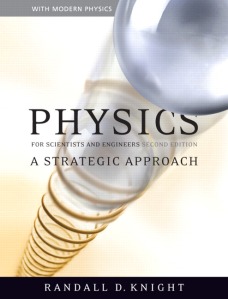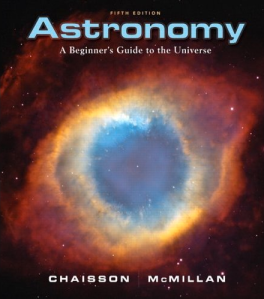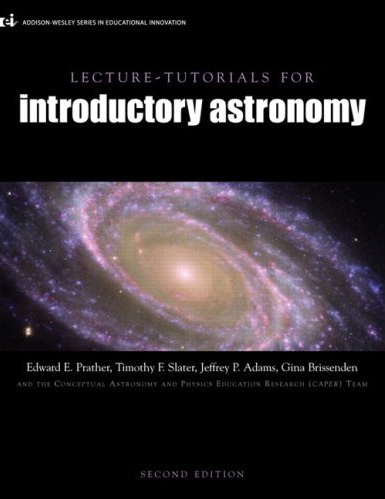Archive
To Teach With or Against the Textbook
This has been a trying semester. Besides juggling a couple of research projects, I’m teaching our calculus-based, introductory physics course for the first time. The material isn’t too challenging, but writing all those lectures, picking homework assignments and then grading them, followed by exam writing and even more grading, has led to very little free time for things like blogging.
Although this new-prep class has been eating away at my time, I’m enjoying the course. For the first time I’m teaching to a reasonably large (34 students) population of future scientists that don’t have a fear of numbers. Moreover, they’re interested in the material. It’s great.
 The one hiccup I have ran into with this class is the textbook. We’re using Randall Knight’s, Physics for Scientists and Engineers: A Strategic Approach
The one hiccup I have ran into with this class is the textbook. We’re using Randall Knight’s, Physics for Scientists and Engineers: A Strategic Approach. I’m not here to bash the book. It’s not perfect, but it’s not all that bad either. As a colleague puts it, all introductory texts have their warts. The problem that I do have with this text is that it presents some material in a way that I don’t agree with. So the question arises, do I toe the line and teach like the textbook presents the material, or do I move away from the text and present the material in my own manner?
Before I delve into the pros and cons of both sides of this argument, I want to mention that it’s not that either side of the argument presents the physics wrong. Using hindsight and years of experience, it’s a trivial manner to demonstrate how the multiple approaches to teaching the same material are one and the same. But to a student encountering the material for the first time, this is anything but true. For this reason, sticking with one approach and rolling with it is so much more conducive to a successful learning environment than one in which multiple strategies are employed and comparisons between techniques are discussed.
Pros for Teaching With the Textbook
The most obvious pro to teaching with the textbook is that the book acts as a resource to the students outside the classroom. Ideally students are spending time outside of class reading the text, studying the examples presented therein, and doing a few practice problems on their own. In studying on their own, it’s important that the students understand the nomenclature and symbols used by the text. By diverging from the text in the classroom students are left with a competing approach to how the material is presented without a personal guide to set the record straight. Since students are encountering the material for the first time (in the case of an introductory course) alternative approaches can be confusing and lead to frustrations.
To strengthen this argument, for those instructors that do require reading outside of the class (such as for Just-In Time Teaching), it seems to me that they are obliged to follow the textbook style. It would be unfair for an instructor to require students to learn the material only to come to class to find out that that is not the way the material will be taught.
Another small pro for teaching with the text is that the more the text is used, the less students feel ripped off by purchasing a high cost book that is never used. I remember being a student and having professors require texts that were barely used. Why spend hundreds of dollars and only use the text a few times during the semester?
Cons for Teaching Against the Textbook
As I see it, there are a few justifiable reasons for teaching against the textbook. The first argument starts with the ultimate goal: to educate the students. To this end, we should use the best pedagogical practices available that we, as instructors, are comfortable using. If those pedagogical approaches differ from what and how the textbook presents the material, then I feel justified in breaking away from the text and teaching using my own style.
Along those same lines, a second reason for teaching against the textbook is that occasionally multiple texts are used in the classroom. In my particular case, we supplement the Knight textbook with the Tutorials In Introductory Physics by McDermott et al. These tutorials often present the physics in a slightly different manner, using different nomenclature and notation. I have made the conscious decision to use a teaching style that closer complements the Tutorials than Knight. My reasoning for this is that the Tutorials introduce a certain systematic approach to handling forces that it introduces a number of safety nets for the students to work with.
The last reason for teaching against the text is that occasionally there are certain topics that a text presents in an unusual manner that may seem not quite right. As an example from introductory physics, different authors define the weight force in different ways. To some the weight force is simply the gravitational force while to others it’s the reading a scale outputs when an object is placed on top of it. Neither approach is more right than the other. It’s just that feel that one approach (defining weight through an interaction with a scale) is more confusing than simply calling it the gravitational force.
In the end, I think it’s up to the instructor to decide for themselves if they will teach with or against the course textbook. The importance in going either way is to always put the students first. Choose the approach that gives the students the best chance at learning the material. I’ve made the personal decision to teach against the text because I want to incorporate the best pedagogical approaches that I’m aware of.
The Astro 101 Textbook Dilemma
It’s that time of the semester where we’re looking ahead and thinking about what the next round of classes brings. Yesterday, the Physics faculty had our biannual meeting where we assign instructors to classes. I’m teaching Astro 101, as expected, in addition to the first semester calculus based physics course. Now that we have our teaching assignments, the next step is to decide on a textbook for adoption. For the introductory physics class, I don’t have a choice on the matter. The faculty have already agreed on a particular text that we’re going to use for a few years. (By adopting a text for multiple years we can save the students money via end of term book buybacks.) For Astro 101, where I’m the only person teaching the course, the book selection process is all up to me.
 I’ve wrestled with the problem of choosing an Astro 101 textbook for a number of years now. When I started as an assistant professor back in 2007 I adopted Chaisson & McMillan’s, Astronomy: A Beginner’s Guide to the Universe for reasons that I’ve since forgotten. At that time I had no prior teaching experience, let alone with Astro 101. I was fresh out of a research postdoc and what little teaching I did in graduate school was as a teaching assistant—basically I taught lab sections of a course someone else designed. In outlining the course I had nothing to go off, only the course description. For this reason I modeled my class after the text. The book’s table of contents became my guide to what was covered in class every day. I’m embarrassed to say this, but I was simply trying to survive as a faculty member.
I’ve wrestled with the problem of choosing an Astro 101 textbook for a number of years now. When I started as an assistant professor back in 2007 I adopted Chaisson & McMillan’s, Astronomy: A Beginner’s Guide to the Universe for reasons that I’ve since forgotten. At that time I had no prior teaching experience, let alone with Astro 101. I was fresh out of a research postdoc and what little teaching I did in graduate school was as a teaching assistant—basically I taught lab sections of a course someone else designed. In outlining the course I had nothing to go off, only the course description. For this reason I modeled my class after the text. The book’s table of contents became my guide to what was covered in class every day. I’m embarrassed to say this, but I was simply trying to survive as a faculty member.
Since those days, I’ve attended a number of teaching workshops and meetings, and I’ve been exposed to the astronomy education research literature. In response, my class has changed drastically. Most importantly I’ve moved away from following a textbook’s table of contents as my guide and I’ve written original course learning objectives. In redesigning the class I’ve found that the material I want to cover is not distributed in the same way as any Astro 101 textbook I’ve seen. The most notable example is that I spend the first third of the class covering celestial sphere ideas: diurnal and annual motions, the seasons, the ecliptic, lunar phases, synodic vs sidereal etc. In most textbooks, all of this material is relegated to a chapter at best. Some topics I cover may only get a few paragraphs of coverage in a typical introductory astronomy textbook.
On the other hand, when I cover topics such as the Hertzsrpung-Russell (HR) diagram, most texts cover the material to a much greater depth than what I expect from my students. Moreover, the material is often presented in a language that I don’t necessarily use. In my class I try to minimize—but not completely eliminate—topic specific jargon. Also, these texts have sections and even chapters of material that I don’t cover in a one semester survey course.
This finally brings me to the question of choosing an Astro 101 textbook and where my dilemma lies. Coincidentally there’s an ongoing exchange on the astrolrner yahoo group discussion board about this very topic right now. I don’t want to use this blog as a reply to the comments there, but I do want to partially highlight the comments made by Tim Slater.
I know that some folks have tried using trade books or coffee table books or extensive fact-based web sites. Although these are attractive, particularly in how they are illustrated, they lack the tried-and-true pedagogical tools that many, many students, publishers, and authors have worked through and tried to perfect over the years – explicitly stated learning goals, headings to structure student thinking, end of chapter summaries with review questions, and, gasp, even bold faced words to help focus student attention. I’m not saying that these things are perfect and are not often overused, BUT, what I would say is that these pedagogical clues are important enough to student readers that having them in a textbook is more important than the pretty pictures and pedagogy-less writing of coffee table books. As it turns out, textbook features DO help students learn better!
He makes a very good point. Textbook authors, Slater being one of them, have now incorporated astronomy education research supported methodologies into their texts. This is what distinguishes textbooks from run-of-the-mill astronomy books you find at a bookstore. More importantly, as an instructor, these unique features are desirable in a supporting text for a class. It’s also one of the reasons I want to adopt a text for my Astro 101 course.
However, and this is where I begin to have difficulties, although the goal of any of these textbooks is to teach astronomy they go about it in very different ways. When an author decides to write a textbook they have to decide what content to cover, to what extend, and using what presentation strategies. These choices are made by first deciding what are the learning objectives—statements about what a student should be able to do after using the text. Once the learning objectives are decided, the text is written to support those goals. For example, some text have the learning objective to instill in the students the ability perform certain calculations, while other texts have learning objectives focused on conceptual understanding. The learning objectives can be very broad—like the examples just give—or they can be very narrow in the case of learning objectives for a particular chapter or topic.
Now the questions arise, if the textbook’s learning objectives don’t align with the course learning objectives should the book be adopted? If no textbooks’ learning objectives align with the course’s learning objectives, should any text be adopted?
 I’ve taken the point of view that if no textbook’s learning objectives align with the course learning objectives, then I won’t adopt a text. In the Astro 101 course I teach at Coastal Carolina (ASTR 101: Conceptual Astronomy) I’ve adopted the Learning-Tutorials for Introductory Astronomy by Prather et al. as the only required text. This particular book is a collection of astronomy education research developed interactive tutorials that are designed to get students actively engaged in the material through peer work. In making this the only required text I’ve put the unfortunate burden on my notes (presentation slides) as being the only source of new information. All definitions and facts come solely from what I deliver to the students. This is an issue I’ve come to recognize and another reason I would like to adopt a text.
I’ve taken the point of view that if no textbook’s learning objectives align with the course learning objectives, then I won’t adopt a text. In the Astro 101 course I teach at Coastal Carolina (ASTR 101: Conceptual Astronomy) I’ve adopted the Learning-Tutorials for Introductory Astronomy by Prather et al. as the only required text. This particular book is a collection of astronomy education research developed interactive tutorials that are designed to get students actively engaged in the material through peer work. In making this the only required text I’ve put the unfortunate burden on my notes (presentation slides) as being the only source of new information. All definitions and facts come solely from what I deliver to the students. This is an issue I’ve come to recognize and another reason I would like to adopt a text.
As I see it, the alternative to not adopting a text is to go ahead and adopt a text that has different learning objectives, a different distribution of topics to cover, more information on some topcis, and at a higher cost to the students than what I want. A second alternative is to restructure my class to teach along the guidelines set forth by a text. For reasons that deserve another blog entry, I don’t like the second option. A third alternative is to compromise and to find a book close to my desired learning objectives. With this path, I’m pushed into the issue of content distribution. I have yet to find a textbook that distributes the material coverage in the way that I like. I don’t want to assign a text to my students (that may be in excess of $125) but only use 10% of the material. It’s not fair to the students.
So here I stand with a desire to adopt an Astro 101 textbook, but without a justification for doing so.
